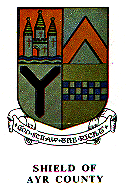SHORT HISTORY OF MAYBOLE AND DISTRICT
 The
ancient Kingdom of Carrick, of which Maybole is the principal town, is the most
southerly of the three divisions of the County of Ayr and was first mentioned by
the Romans during their occupation of south Scotland. The district was then
inhabited by the Damnii, whose religion was Druidism and there are many
Druidical remains throughout the area. The earliest known inhabitants about
2,000 years ago. were crannog dwellers at Loch Spouts about two miles from
Maybole.
The
ancient Kingdom of Carrick, of which Maybole is the principal town, is the most
southerly of the three divisions of the County of Ayr and was first mentioned by
the Romans during their occupation of south Scotland. The district was then
inhabited by the Damnii, whose religion was Druidism and there are many
Druidical remains throughout the area. The earliest known inhabitants about
2,000 years ago. were crannog dwellers at Loch Spouts about two miles from
Maybole.
In the fifth century the people of Carrick were converted to Christianity and since then the area has been closely connected with religious houses, the greatest of these being Crossraguel Abbey about two miles from Maybole, built for the Cluniac monks about 1244 and occupied until 1592. The Abbots of Crossraguel were noted throughout Scotland for their learning and it was one of the few places in Scotland where the monks minted their own coinage. Another famous ecclesiastical building was the Collegium or Collegiate Chapel, built in Maybole in 1371. This was Scotland’s first Collegium, with a Provost and three Prebendaries, and daily services were held as in a cathedral.
The ruins of Crossraguel Abbey and the Collegium are now maintained by the Ministry of Ancient Monuments. The district is steeped in Covenanting history and Peden and Cargill often preached in the fields around Maybole. The largest conventicle ever held in Scotland was at Craigdow, about 3 miles from the town. when over 5,000 people gathered for worship, with sentries posted to watch for the troopers of the notorious Grier of Lagg who was stationed in Maybole to persecute the Covenanters. It is interesting to note that the first man enrolled in the Cameronian Regiment raised in 1689 to commemorate the great Covenanter, Richard Cameron, was a man named John Slaven from Culdoon at Maybole.
Carrick in early times played a prominent part in the history of Scotland and the traditional birthplace of Robert the Bruce is at Turnberry, about 7 miles south of Maybole. It was at Turnberry Castle Bruce struck the first blow for Scotland’s independence and the whole district has many associations with the stirring times of that period. At Bannockburn, where Scotland finally gained independence, it is said that Bruce ordered that his bodyguard should be composed of "his ain men from Carrick"
Later the Kennedys became the all powerful family in Carrick and continued for centuries to keep the district to the forefront in Scotland’s affairs. Gilbert Kennedy, 3rd Earl of Cassillis was Lord High Treasurer of Scotland in the middle of the 16th century and was appointed as one of the Commissioners to arrange the marriage of Mary Queen of Scots to the Dauphin of France. The crest on the Maybole Coat of Arms is a dolphin and tradition has it this is a pun on the name "Dauphin"